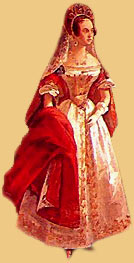 Russian
Court Dress Russian
Court Dress
The Russian Imperial Court was a place of splendor and
pride. Court dress in Russia was a very specific thing. It was
introduced by Nicholas I in 1834 and loosely based on traditional
Russian styles.
The Russian Court was no different to other Courts in
that everyone vied to be the most fashionable and the most talked-about.
As the imperial capital, St Petersburg's
inhabitants from the highest to the lowest have always known
the importance of dressing to impress.
|
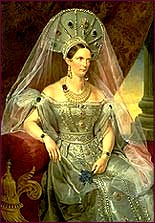 This
portrait shows the Empress Alexandra, wife of Tzar Nicholas
I, in a Russian court dress. This
portrait shows the Empress Alexandra, wife of Tzar Nicholas
I, in a Russian court dress.
Both Alexandra's beauty and her love of elegant things
are obvious in this portrait.
She's wearing many pieces of jewelry and an elaborate dress
which at the time was the standard court dress. The fanciful
headdress was based on a traditional Russian
costume. In her hand she's holding a little bouquet of fresh
cornflowers, the same color as her eyes.
|
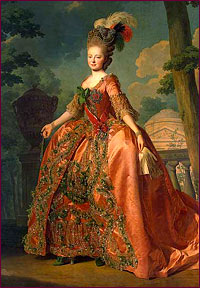 "The
richness and splendour of the Russian court is above all pretentious
descriptions. The traces of ancient Asian magnificence are mixed
with European exquisiteness. A huge suite of courtiers either
follow or preceed the Empress. "The
richness and splendour of the Russian court is above all pretentious
descriptions. The traces of ancient Asian magnificence are mixed
with European exquisiteness. A huge suite of courtiers either
follow or preceed the Empress.
Luxurious and brilliant full dresses and abundancy
of precious stones on them are much more magnificent than at
any other European court... Of the luxury articles of the Russian
nobility we foreigners are most of all astonished with the abundancy
of precious stones shining on different parts of their costume...
Many of the noblemen are almost studded with diamonds",
wrote the English traveller and historian William Cox who visited
the Winter Palace receptions.
|
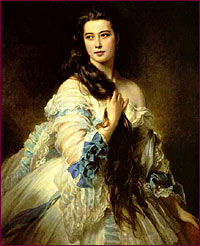 As
compared with magnificence of the court way of life the personal
requirements of Tsarina Catherine ll were moderate as she intentionally
pointed it out. The state secretary of Catherine II who described
the last ten years of her reign Gribovskoy indicated that she
wore a plain loose dress of grey or violet silk. Orders and
jewellery decorated her costume made of brocade or velvet all
in the same style only at gala receptions. As
compared with magnificence of the court way of life the personal
requirements of Tsarina Catherine ll were moderate as she intentionally
pointed it out. The state secretary of Catherine II who described
the last ten years of her reign Gribovskoy indicated that she
wore a plain loose dress of grey or violet silk. Orders and
jewellery decorated her costume made of brocade or velvet all
in the same style only at gala receptions.
She introduced a fashion of wearing "Russian style"
dresses at the court and used elements of national costume in
her attire.
|
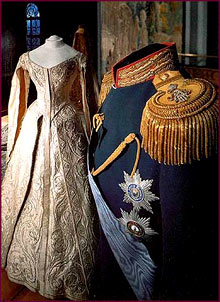 "The
Russian court dress was exceedingly picturesque and was donned
for all bigger occasions. It consisted of amply cut velvet robes
over a tablier of white satin; the shape, with its train, and
wide, long-hanging sleeves, had something medival about it.
These robes were heavily embroidered in silver or gold and were
of every colour of the rainbow; the richest of all were of cloth
of gold or silver. A halo-shaped
cocoshnic with a veil hanging from beneath it inevitably accompanied
this costume, so that every woman appeared to have been crowned.
This unity of attire made all Russian court gatherings uniquely
picturesque, saturating them with colour and brilliance unlike
anything else; veritable pictures out of the "Thousand
and One Nights," Byzantine in splendour, with all the mysterious
gorgeousness of the East. In those days the processional entry
of the Russian Imperial family into festive hall or saint-haunted
church was a picture once seen never to be forgotten."
- Marie, Queen of Roumania, from the book "The Story of
My Life". "The
Russian court dress was exceedingly picturesque and was donned
for all bigger occasions. It consisted of amply cut velvet robes
over a tablier of white satin; the shape, with its train, and
wide, long-hanging sleeves, had something medival about it.
These robes were heavily embroidered in silver or gold and were
of every colour of the rainbow; the richest of all were of cloth
of gold or silver. A halo-shaped
cocoshnic with a veil hanging from beneath it inevitably accompanied
this costume, so that every woman appeared to have been crowned.
This unity of attire made all Russian court gatherings uniquely
picturesque, saturating them with colour and brilliance unlike
anything else; veritable pictures out of the "Thousand
and One Nights," Byzantine in splendour, with all the mysterious
gorgeousness of the East. In those days the processional entry
of the Russian Imperial family into festive hall or saint-haunted
church was a picture once seen never to be forgotten."
- Marie, Queen of Roumania, from the book "The Story of
My Life".
|
 Although
she had already attended three balls that week, it would not
be unusual for a Russian woman of noble standing to look forward
to yet another night of festivity in the city. It would not
be unusual, as well, for her husband to complaine that each
flounce of her dress costs more than an abbot's robe of gold
brocade. Although
she had already attended three balls that week, it would not
be unusual for a Russian woman of noble standing to look forward
to yet another night of festivity in the city. It would not
be unusual, as well, for her husband to complaine that each
flounce of her dress costs more than an abbot's robe of gold
brocade.
Rich jewellery was worn at
all times and vertually all of it - rings, bracelets, necklaces,
tiaras, pins, shoe buckles, hair ornaments, watches, swords
- was studded with diamonds and other precious stones. The cold
Russian climate demanded equally sumptuous coats and hats, and
of course, these had to be examples of high fashion.
|
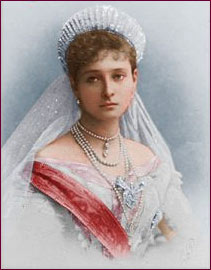 The
Russian costumes of the former times are scarcely ever worn
today though they serve a source of inspiration to many a fashion
designers throughout the world. The
Russian costumes of the former times are scarcely ever worn
today though they serve a source of inspiration to many a fashion
designers throughout the world.
The industrial development of the 20th century had put
its impact on the fashion designs introducing new technologies
and materials. Yet the motifs of the older days, the best traditions
of style and form are often used by modem designers to diverse
and make their top fashion creations especially picturesque
and luxurious.
The
Pavlovsk Museum has a large collection of costumes belonged
to different representatives of the Russian Imperial Family.
 |
|
|
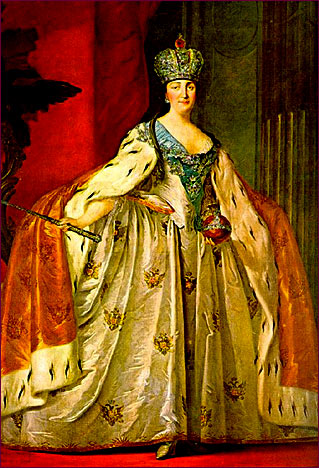
Portrait of the Empress Catherine
ll, Levitski.
|

|
|
Table Settings
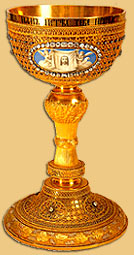 The
gold and silverware decorated with precious stones and pearls,
such as cups, loving-cups, win-cups and Korchiks (small dippers),
conjure up vivid pictures of court life during the 17th century. The
gold and silverware decorated with precious stones and pearls,
such as cups, loving-cups, win-cups and Korchiks (small dippers),
conjure up vivid pictures of court life during the 17th century.
Seramics, of all decorative art forms, was
the one most intensively cultivated in Imperial Russia.
Its development began not with Peter
the Great, who had sent his emissaries to Peking to wrest
from the Chinese their secrets of their exquisite ware, but
with his expansive, willful daughter, Empress Elizabeth.
|
 Porcelain
was first brought to Europe by Marco Polo from China, and the
secret of its manufacturing remained unknown to Russians until
1740 when a young metallurgist was sent to Germany to study.
With this new knowledge, the first Russian porcelain factory
was opened in 1744 under the patronage of Empress Elizabeth,
and still exists today. Porcelain
was first brought to Europe by Marco Polo from China, and the
secret of its manufacturing remained unknown to Russians until
1740 when a young metallurgist was sent to Germany to study.
With this new knowledge, the first Russian porcelain factory
was opened in 1744 under the patronage of Empress Elizabeth,
and still exists today.
|
Though
beautiful dishes imported from Europe graced her table, she
nonetheless felt her surroundings were incomplete without an
abundant supply of porcelain produced in her own factories.
Elizabeth's pursuite was not self-serving for she saw it as
a means for generating commercial profit and as a way of nurturing
"home art".
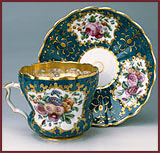 The
primary business of the emerging porcelain industry was to supply
the royal courts with hard-paste porcelain table services, decorative
pieces for elaborate state banquets, and pieces for their private
use. Russian banquets often lasted up to nine hours and required
vast amounts of tableware. Porcelain's translucent beauty and
durability was valued as a decorative accent for the banquets.
The difficulty and expense of manufacturing porcelain demonstrated
the Russian empire's sophistication, and porcelain was often
presented as gifts to state and foreign visitors. The
primary business of the emerging porcelain industry was to supply
the royal courts with hard-paste porcelain table services, decorative
pieces for elaborate state banquets, and pieces for their private
use. Russian banquets often lasted up to nine hours and required
vast amounts of tableware. Porcelain's translucent beauty and
durability was valued as a decorative accent for the banquets.
The difficulty and expense of manufacturing porcelain demonstrated
the Russian empire's sophistication, and porcelain was often
presented as gifts to state and foreign visitors.
|
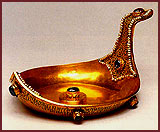 Traditional
Russian tea was poured into porcelaine cups from steaming samovars. Traditional
Russian tea was poured into porcelaine cups from steaming samovars.
Other examples of uniquely Russian objects found on banquet
tables were "kovshi". There were large ones from which
punch was poured and miniature ones that were used as saltcellars.
In time this unusual-looking object became so identifyed
with Imperial honor that it grew to be more desirable than any
other ceremonial gift.
|
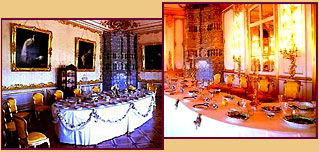 |
Click
here to learn about the collection of Western European and
english porcelain in Pavlovsk Museum, one of the richest in
the suburban Imperial palaces.
|
|
|
|


